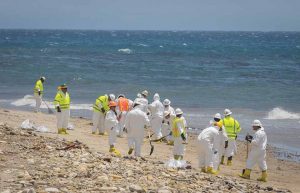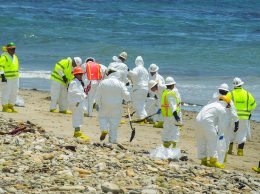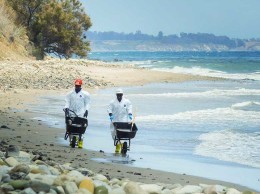Feds propose tougher oil pipeline safety rules
IN THIS ARTICLE
- Energy Topic
- pacbiztimes Author
By pacbiztimes Friday, October 2nd, 2015
The federal body governing pipeline safety has proposed new regulations that would change how oil and gas pipelines are operated, inspected and maintained.
The U.S. Department of Transportation Pipeline and Hazardous Materials Safety Administration came out with a draft of new rules on Oct. 1 in response to an oil spill in 2010 that leaked close to a million gallons of crude into Michigan’s Kalamazoo River.
More recently, the May 19 Refugio oil spill released an estimated 143,000 gallons of crude oil that soiled the Gaviota coastline. Houston-based Plains All American Pipeline, which owns and operates the 10.6-mile Line 901 that runs parallel to Highway 101, was worn down to 1/16th of an inch, PHMSA said. Plains lowballed the spill’s size by more than 40,000 gallons in its initial projections.
Even though a Plains operator shut down the line at 11:30 a.m., it didn’t notify the National Response Corporation, a federal body that coordinates emergency responses, until 2:56 p.m.
Local officials and lawmakers have since urged better pipeline inspection regulations, a more coordinated emergency response protocol and improved pipeline technology.
Some of PHMSA’s rule proposals include requiring that all pipelines have a system for detecting leaks and establishing a timeline for pipeline inspections following a storm or natural disaster.
PHMSA also would require operators to annually evaluate the protective measures for pipelines in “high consequence areas,” and improve the quality and frequency of maintenance tests as well as repairs.
“The proposed rule would significantly change the way operators manage risk and promote the safe operation of the almost 200,000 miles of hazardous liquid pipelines in the United States,” PHMSA Administrator Marie Therese Dominguez said in a news release. “The new requirements would strengthen the standards that determine how operators repair aging and high-risk infrastructure, increase the quality and frequency of tests that assess the condition of pipelines, and require that all hazardous liquid pipelines have a system to detect leaks.”
While it’s a step in the right direction, U.S. Rep. Lois Capps, D-Santa Barbara, said PHMSA has a long way to go.
“I remain frustrated by how long it has taken PHMSA to roll out these basic safety improvements and will continue working with my colleagues and PHMSA to ensure federal pipeline safety regulations are as strong as possible,” she said in a prepared statement.
PHMSA’s proposed regulations do not include new mandates for installing automatic shutoff valves, which Line 901 did not have. It follows the Pipeline Safety Act of 2011, which only requires automatic valves in newly constructed or entirely replaced pipelines, the proposal reads.
PHMSA intends to move forward with a separate rule regarding automatic valve usage in the near future, a PHMSA representative told the Business Times.
State Assemblymember Das Williams, D-Santa Barbara, authored AB 864 that requires intrastate pipelines in environmentally and ecologically sensitive areas along the coast to use the best preventative technology such as leak detection and automatic shutoff valves.
State Sen. Hannah-Beth Jackson, D-Santa Barbara, authored SB 295, which would require annual pipeline inspections by state regulators, and SB 414, which would allegedly make oil spill response faster and more effective.
All three bills await Gov. Jerry Brown’s signature.
Officials lamented the fact that Plains’ operations in the Tri-Counties fall under the classification of an interstate pipeline, which means it has to abide by less stringent regulations than the state’s. Plains inspects its pipelines every three years even though the federal government only requires one every five years.
Plains’ inspection in 2012 didn’t raise enough alarm to trigger action. It had another inspection about two weeks before the spill but didn’t receive the results in time, the company said.
As of now, PHMSA only regulates gathering lines that meet certain size, location and operating pressure; some pipelines in rural areas fly under the radar. It governs less than 4,000 miles of the approximately 30,000 to 40,000 miles of onshore lines in the country, the proposal states. The other 90 percent is not subject to any minimum federal standards.
The proposal would extend reporting requirements to all gathering lines, a PHMSA official said.
• Contact Alex Kacik at [email protected].












